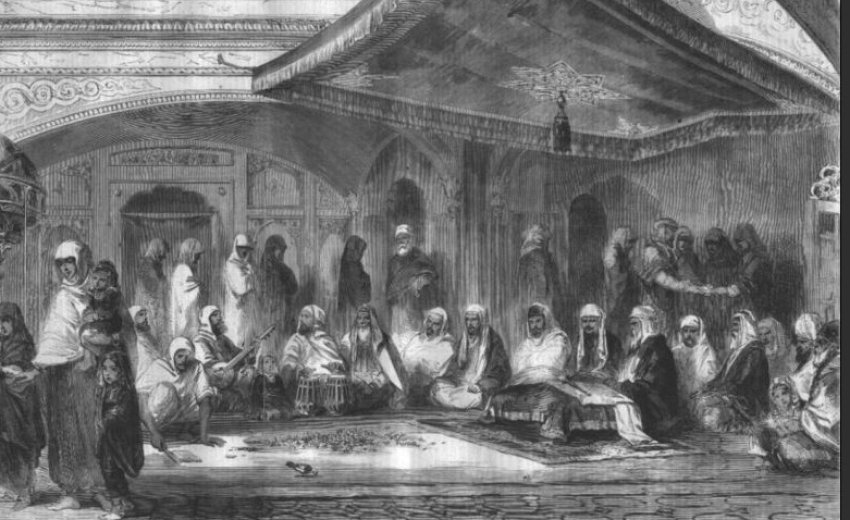 The stringed instruments of the Sikhs are slowly returning to their rightful place in Guru's court, as more people take up learning Gurmat Sangeet and 'tanti saaj'. But what is all the fuss about? If Sikhs can learn kirtan on a harmonium, why go through all that effort to learn an ancient instrument and spending years trying to master it?
The stringed instruments of the Sikhs are slowly returning to their rightful place in Guru's court, as more people take up learning Gurmat Sangeet and 'tanti saaj'. But what is all the fuss about? If Sikhs can learn kirtan on a harmonium, why go through all that effort to learn an ancient instrument and spending years trying to master it?
The harmonium is simple, easy to pack and carry around, and most of all, easy to learn. Its creator, Alexandre Debain, never imagined that an entire race would use it as their main instrument for expressing their love for God. The harmonium has become an institution in the homes of all those who want Sikhism to grow fruitfully in their lives and within their family. And it has allowed millions of people to sing and express Gurbani without much difficulty. The harmonium has become the defining feature of Sikh kirtan in the modern age, heralding from the early 20th century. Gurdwaras worldwide hire two harmonium players and an accompanying percussionist to seat themselves on stage and sing hymns from the Holy Guru Granth Sahib with ease and precision. Their benefit is speed. There is no prior tuning involved, nor do their instruments require warming up or any treatment.
Harmonium players can just sit on stage and begin before the sangat begin to rustle at the lack of action, or decide to exit from boredom or impatience.  Listeners of the 'tanti saaj' are slightly different. They sit calmly and listen while the raagis tune their instruments and align their instruments in unison with each other's and the tanpura's constant drone, each sympathetic string one by one until they hear sheer melody from the resonating strings. The sangat tries to join in by tuning their own minds to the pure drone and blocking out all other sounds and senses, feeling at one with the timeless Lord. They watch the raagis lovingly apply resin to their bows and prepare their hands, for the next hour of blissful sounds of Gurmat Sangeet, with an application of powder or oil to their fingers, which makes them glide across the strings. Then the listeners prepare their ears for the instrumental shaan; the instruments salute to their Guru and introduce the raag and flavour of today's kirtan. The sangat are woken from their dreamy haze by the booming jori pounding its heartbeat on the unsuspecting listeners; the dilruba, stealing the sangat's heart with its sweetness; the hundred colours of the sarangi that brings with it the ancient stories of Raavan; the graceful sounds of the peacock emulating from the glorious taus; the humility of Guru Arjan's Saranda; and the gentleness of Bhai Mardana's rabab, that so humbly accompanied the father of the Sikhs, Guru Nanak, on his journeys to spread the truth.
Listeners of the 'tanti saaj' are slightly different. They sit calmly and listen while the raagis tune their instruments and align their instruments in unison with each other's and the tanpura's constant drone, each sympathetic string one by one until they hear sheer melody from the resonating strings. The sangat tries to join in by tuning their own minds to the pure drone and blocking out all other sounds and senses, feeling at one with the timeless Lord. They watch the raagis lovingly apply resin to their bows and prepare their hands, for the next hour of blissful sounds of Gurmat Sangeet, with an application of powder or oil to their fingers, which makes them glide across the strings. Then the listeners prepare their ears for the instrumental shaan; the instruments salute to their Guru and introduce the raag and flavour of today's kirtan. The sangat are woken from their dreamy haze by the booming jori pounding its heartbeat on the unsuspecting listeners; the dilruba, stealing the sangat's heart with its sweetness; the hundred colours of the sarangi that brings with it the ancient stories of Raavan; the graceful sounds of the peacock emulating from the glorious taus; the humility of Guru Arjan's Saranda; and the gentleness of Bhai Mardana's rabab, that so humbly accompanied the father of the Sikhs, Guru Nanak, on his journeys to spread the truth.
With this mesmerising array of sounds and stories to share, it is difficult to believe that the Gurus' companions are today forgotten relics, replaced by a German organ. This neglect is a result of our own actions. As our lives become faster and busier, speed takes control of our day. We make no time for praying; no time for meditating on the truth; we struggle to sit cross-legged on the Gurdwara floor because we are too used to our desk jobs and swivel chairs; we fail to appreciate Mother Nature for her glorious theatrical displays, but curse her for delaying our trains; we forget our duties as human beings whilst busy earning a dollar to feed our families. We lose ourselves. So, we need quick fixes of prayer, meditation, kirtan and inspiration. We need something that will fit into our 9-5 lives and not keep us too long from our worldly duties; hence the harmonium. It allows us to learn quickly and produce shabads without too much hard work.
Harmonium classes across the world mass-produce kirtanis and shabads like furniture in Ikea. Just pick what shabad you like from the shelf and you can put it together yourself. They are simple and easy to manage, and hey, they are trendy!
But is this what kirtan is about? Why are Sikhs impatient and pre-occupied? They are born from generations of leaders yet they cannot devote time to their amazing heritage, they cannot invest in the future of their children, or give them the strength of the forefathers and martyrs from their past. These saints are commonly referred to as the people from 'that time back then' and we immediately segregate ourselves from Sikhi's diamonds.
 But the strength of those masters came from their lifestyles and choices. And we can choose to live a saintly life also. By choosing a path of speed and ease, we open our lives to impatience and ignorance. But we can decide to take control of our lives by opting to live in the same light of our Gurus, by making the right choices, and being awake to hear what is going on.
But the strength of those masters came from their lifestyles and choices. And we can choose to live a saintly life also. By choosing a path of speed and ease, we open our lives to impatience and ignorance. But we can decide to take control of our lives by opting to live in the same light of our Gurus, by making the right choices, and being awake to hear what is going on.
Gurmat Sangeet is one way to live a saintly life. By choosing to pick up the Gurus' instruments, you choose to live a life of Sehaj, where you will continue learning for your entire life and surrender to the Guru's hukam.
As you learn how to care for your instrument you will gain respect for your Guru and the Sadh Sangat. When hearing the sacred sounds of the blessed instruments and reciprocating them, you will learn to understand the musicology of your neighbours and how to reply to their anger or greed.
While balancing your bow and controlling your rhythm, you will be overcome with empathy and will care for those less fortunate than yourself, nourishing their minds bodies and souls with your own hands and hard-earned resources. As you sing the Gurus' own words, you will begin to speak only sweetness and goodness from your blessed tongue. You will learn to love and respect Mother Earth and will walk in harmony with her hearbeat. You will gain the attributes of a Sikh and will radiate Waheguru to all you meet.
